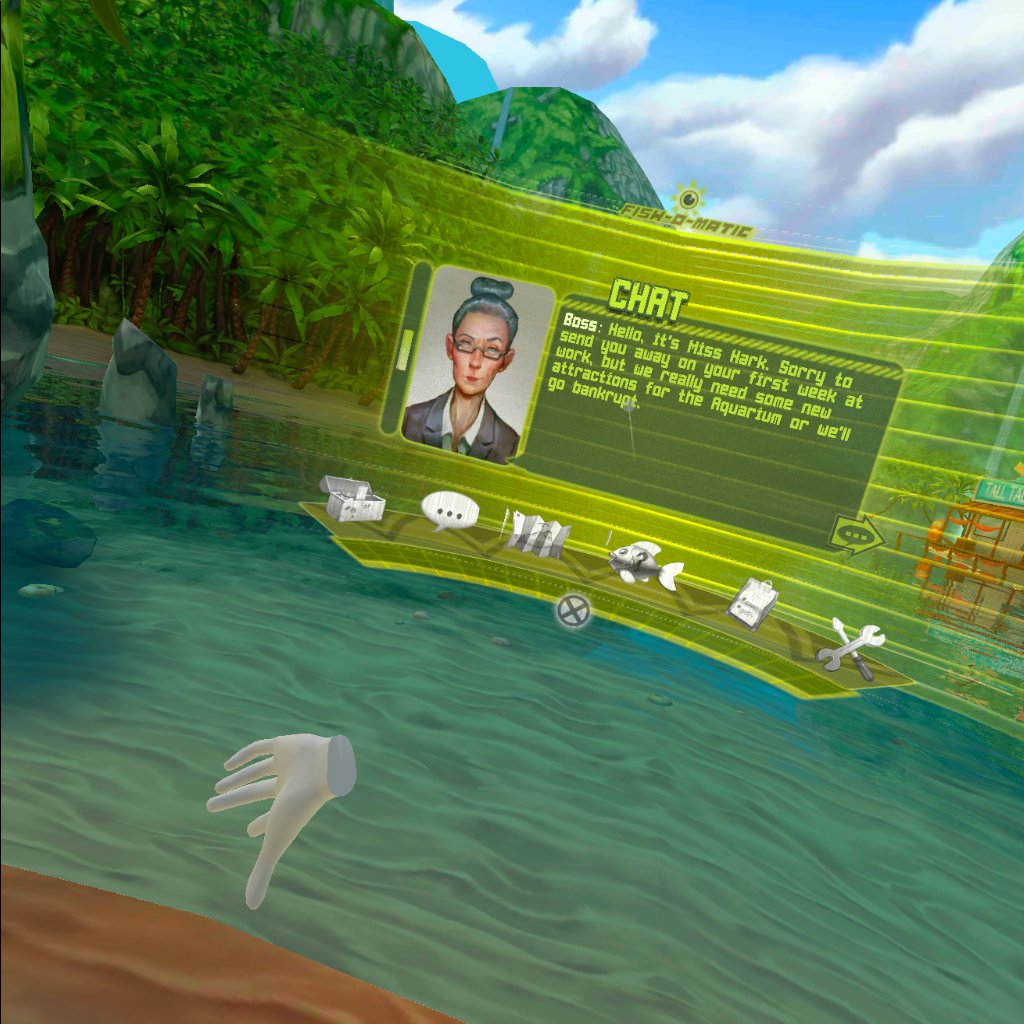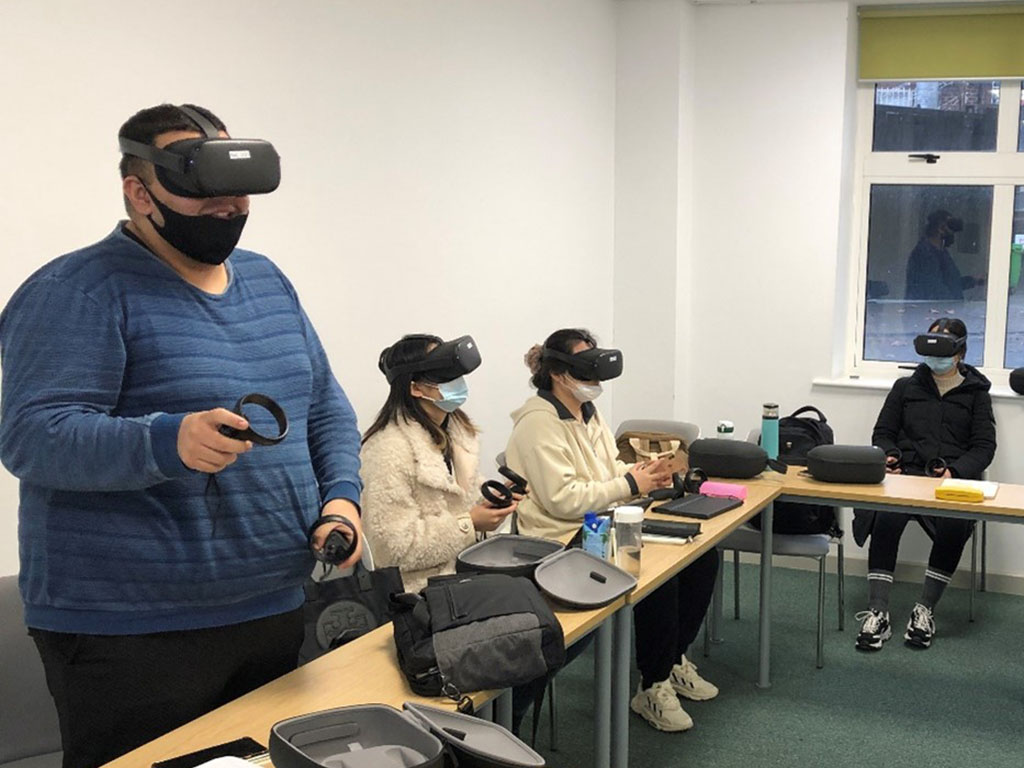Virtual Reality Play and Serious Content - Watching Traveling While Black in a Master’s Seminar Group
The MA Digital Literacies, Culture and Education has been working to integrate Virtual Reality content into our teaching, such as getting students to critically discuss 360° footage of Hillsborough Park during the pandemic, which Dr Becky Parry wrote about here. Now that the university is open again for face-to-face teaching, I arranged a session around my current VR research for the module “Digital Culture and Childhoods.”
With support in planning from Senior Learning Technologist Hadrian Cawthorne, and support on the day from the Media/TEL Officer Patrick Derbyshire, we brought an Oculus Quest headset for each student to the lecture room. After a brief introductory lecture on definitions of VR, research on VR and childhood, and some theories about the affordances of VR as a medium, everybody had a go at setting up a headset for themselves, creating a boundary space so that they wouldn’t bump into other people, and trying out some free games that Hadrian had prepared on the headsets. These games include the highly popular Beat Saber, the fishing game Bait!, the boxing game Creed, creative apps like the art app Tiltbrush, and more.

As it is generally advised not to wear the headsets for more than 20 minutes at a time, we took a break from the headsets at that point, to discuss their initial reflections on it. We talked about how their experiences related to some common concepts in research on VR, such as on-boarding (what you see/where you are when you first enter the virtual space), embodiment, and interaction. We reflected on ideas of multimodality, and how engaging and effective a tool VR could be for both play and creativity.
In the afternoon session, students were seated with their headsets on to watch a 360° cinematic VR documentary, titled Traveling While Black. This is a documentary I came across during research for the Storyland project, while exploring different types of narrative form in VR. It is a powerful experience to see testimonies from Black people in America who have experience of police brutality and endemic racism. For most of the documentary, viewers are sat at a table in Ben’s Chili Bowl, a diner in Washington, D.C., with a history of supporting and providing sanctuary for Black communities. We hear the speakers talking to each other, and we are silent witnesses to their memories and narratives, including people talking about the green book, segregated buses, police violence and, at the end of the documentary, the memories of Samaria Rice on the day that her son, Tamir Rice, was killed by police, at the age of 12. It is a heartbreaking narrative, and made all the more powerful by the feeling of presence and emotional proximity, from being in an immersive virtual space.

This module engages students with different digital media, cultural content for children, and theoretical approaches to analysing that content. For many weeks of the programme, we look at children’s film (such as Princess Mononoke) and television (for example Sesame Street) in relation to critical lenses, including feminism, queer theory, ecocriticism, theories of play and critical disability studies. For this week, we connected the digital phenomenon to ideas about multimodality, and Critical Race Theory. I am keen for the students to engage with a wide range of cultural diversity in the module. As a highly international programme (this year, we have students from four countries), I didn’t want to assume any pre-existing knowledge on anti-Black racism, and they told me at the beginning that they were not very familiar with the lives of Black people in the USA. I was interested to see what they would learn, not only about the affordances of VR, but also about the lives of young Black people in America, from this documentary, and what impact it would have on them. One student, David Evers Gomez, reflected after watching it that “It is a story that can only be told in VR.” Research shows that, because VR is different from 2D cinema in how the spectacle is “framed,” it means that we emotionally engage with VR content in a different way, and I could see that students had felt, not only the playful and creative potential of VR from the morning session, but its profound potential to tell stories and invite us to see other lives from a new perspective, from this documentary. In other words, we shared how VR can be put to use for Social Justice education, and engage people of all ages with serious content.
Below are a few practical recommendations for using VR face-to-face in teaching:
- Book a suitable room early. Hadrian and Timetabling helped me pick out a flat room with at least two metres’ space per student, and moveable furniture, to clear space for them to set their boundaries without any risk to each other. (Note: this is especially important if someone is playing a boxing game!)
- Pre-download any apps you want to use, to save time downloading them during the session.
- Allocate plenty of time to students getting used to setting up and navigating menus in the headsets. This took me a lot of time to understand when I first started using VR, as well, so it is a genuine challenge when you’re not familiar with the technology. Being prepared with slides to show the process to the students, or a screencast to walk them through it, would be ideal.
- Enjoy! When the students had got the hang of entering and navigating the virtual world, they told me they were fully converted to VR advocates. I could see it was a powerful experience for them, and they would want to come back for more.
I was delighted to hear that two of the students designed a VR activity for their assignment for Becky’s module on “Digital Literacies in Education,” and I hope to see more engagement with it in their upcoming modules and dissertations.